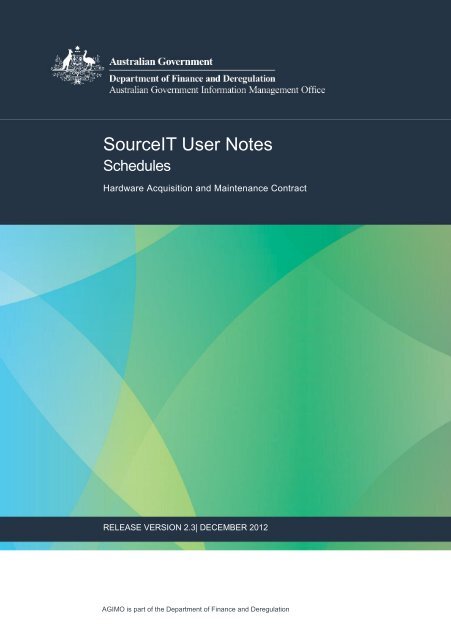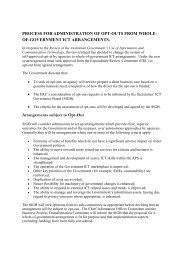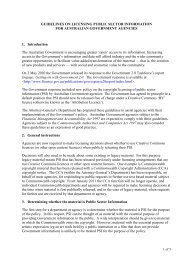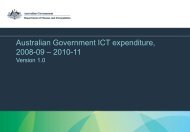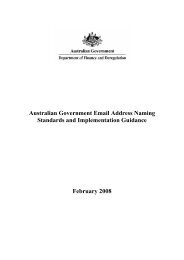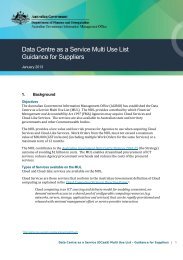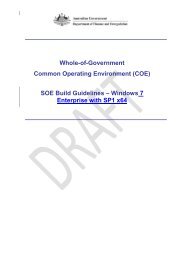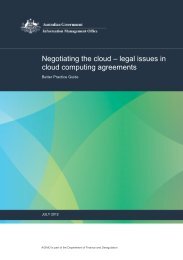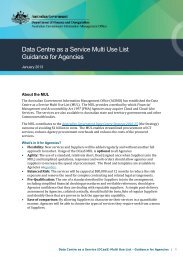Hardware Acquisition and Maintenance Contract - Australian ...
Hardware Acquisition and Maintenance Contract - Australian ...
Hardware Acquisition and Maintenance Contract - Australian ...
Create successful ePaper yourself
Turn your PDF publications into a flip-book with our unique Google optimized e-Paper software.
SourceIT User NotesSchedules<strong>Hardware</strong> <strong>Acquisition</strong> <strong>and</strong> <strong>Maintenance</strong> <strong>Contract</strong>RELEASE VERSION 2.3| DECEMBER 2012AGIMO is part of the Department of Finance <strong>and</strong> Deregulation
SourceIT User Notes - Schedules<strong>Hardware</strong> <strong>Acquisition</strong> <strong>and</strong> <strong>Maintenance</strong> <strong>Contract</strong> 3Introduction 31. Using these notes 32. Using the correct version 33. Purpose <strong>and</strong> structure of the Schedules 3Guidance on specific Schedules 44. Schedule 1 – <strong>Contract</strong> Details 45. Schedule 2 – Statement of Work 56. Schedule 3 – Payment 77. Schedule 4 – Designated Confidential Information 118. Schedule 5 – Customer Requirements 129. Schedule 6 – Change Order 1210. Schedule 7 – Agency Order Form 1311. Schedule 8 – Open Source Licence 1312. Schedule 9 – Confidentiality <strong>and</strong> Privacy undertaking 14© Commonwealth of Australia 2012 page 2SourceIT | User Notes | <strong>Hardware</strong> <strong>Acquisition</strong> & <strong>Maintenance</strong> <strong>Contract</strong> - Schedules | Release version 2.3
<strong>Hardware</strong> <strong>Acquisition</strong> <strong>and</strong> <strong>Maintenance</strong><strong>Contract</strong>Introduction1. Using these notesThese User Notes contain an explanation of the purpose of the Schedules to the<strong>Hardware</strong> <strong>Acquisition</strong> <strong>and</strong> <strong>Maintenance</strong> model <strong>Contract</strong> (model <strong>Contract</strong>).Where relevant, hints for the use of Schedules are also included. For guidance onthe 'Specific clauses' <strong>and</strong> 'General requirements' sections of the model <strong>Contract</strong>,please see the SourceIT website for the corresponding User Notes (User Notes –Specific Clauses <strong>and</strong> User Notes - General Requirements).The explanations in these User Notes appear in the same order in which theSchedules appear in the model <strong>Contract</strong>. Capitalised words in these User Notesrefer to defined terms in the model <strong>Contract</strong>.Further advice, additional to that contained in these User Notes, can be obtainedfrom the <strong>Australian</strong> Government Information Management Office (AGIMO) byemail to ICTProcurement@finance.gov.au or through the Help Desk on (02) 62151597. Advice can also be sought from your legal or procurement adviser <strong>and</strong>should be sought on issues particularly relevant to your organisation.2. Using the correct versionThe most recent version of the model <strong>Contract</strong> is available at the SourceITwebsite. Only the most recent version of the model <strong>Contract</strong> should be used.AGIMO advises against modifying or using a modified version of the model<strong>Contract</strong> without consulting your legal or procurement adviser. AGIMOrecommends that users download the model <strong>Contract</strong> from the website each timesuch a contract is required, to ensure users have the most up-to-date version of themodel <strong>Contract</strong>.3. Purpose <strong>and</strong> structure of the Schedules3.1 PurposeThe purpose of the Schedules to a <strong>Contract</strong> is to set out the specific requirementsfor the procurement. The Agreed Terms of the <strong>Contract</strong> have been drafted to beused with minimum or no alteration for the majority of procurements, with anyvariations to the default positions to be set out in the Schedules. This designallows procurement officers <strong>and</strong> suppliers to focus on the requirements specific totheir particular project rather than the st<strong>and</strong>ard terms <strong>and</strong> conditions.3.2 PriorityThe order of priority of the documents which comprise a <strong>Contract</strong> is set out inclause 2 of the Agreed Terms (for further information, refer to the User Notes –Specific Clauses). The Agreed Terms of this model <strong>Contract</strong> override theSchedules, to the extent of any inconsistency, with the exception of the OpenSource Licence provisions.© Commonwealth of Australia 2012 page 3SourceIT | User Notes | <strong>Hardware</strong> <strong>Acquisition</strong> & <strong>Maintenance</strong> <strong>Contract</strong> - Schedules | Release version 2.3
Guidance on the specific Schedules4. Schedule 1 – <strong>Contract</strong> DetailsPurposeThis Schedule sets out the variables for the <strong>Contract</strong>, including any variation fromthe default position set out in the Agreed Terms. Each item in the <strong>Contract</strong>Details refers to a specific clause in the <strong>Contract</strong> <strong>and</strong> has brief user notes to assistparties to complete the items appropriately.Hints for useCustomers should carefully consider the default position of each clause beforeagreeing to vary the clause, <strong>and</strong> be mindful of the fact that a variation agreed tofor one project or purchase may not be appropriate for another. The variation ofthe default position of a clause may have a significant impact on a project <strong>and</strong>should be considered in the context of the business requirements of the Customerin respect of that project. Please also refer to the User Notes for each of theclauses referenced in the <strong>Contract</strong> Details.Items which require careful consideration prior to amending include:(a) Removal of equipment (item 12)This item is linked to clause 9 (Removal of Equipment) – please refer tothe relevant User Note for this clause.The default position expressed in clause 9 is that the <strong>Contract</strong>or is notrequired to remove any equipment from the Customer's premises. If theCustomer requires the <strong>Contract</strong>or to remove equipment:(i)(ii)this must be stated in this item; <strong>and</strong>regard should be given to the Environmental Purchasing Guide.(b) Intellectual property rights in <strong>Contract</strong> Material (item 26 to 29)Refer to User Notes - Specific Clauses for further guidance in relation toIntellectual Property Rights.Customers are encouraged to seek advice from their legal or procurementadvisers before deciding on appropriate Intellectual Property Rightsclauses.The Statement of Intellectual Property Principles for <strong>Australian</strong>Government agencies is a whole of government approach to themanagement of intellectual property by government agencies. Furtherinformation on the Statement of Intellectual Property Principles can befound at the Attorney General's Department website.(c) Capping of Liability (items 30 to 33)These items are linked to clause 32 (refer to the relevant section of theUser Notes – General Requirement). Before setting a cap on liability© Commonwealth of Australia 2012 page 4SourceIT | User Notes | <strong>Hardware</strong> <strong>Acquisition</strong> & <strong>Maintenance</strong> <strong>Contract</strong> - Schedules | Release version 2.3
through item 30, Customers should have regard to the guidance on thisissue provided in:(i)(ii)(iii)(iv)Finance Circular 2006/03 Limited Liability in Information <strong>and</strong>Communications Technology <strong>Contract</strong>s <strong>and</strong> the accompanying Aguide to limiting supplier liability in ICT contracts with <strong>Australian</strong>Government agencies;Commonwealth Procurement Rules;Finance Circular 2003/02; <strong>and</strong>Financial Management Guidance No. 6 (Guidelines for Issuing<strong>and</strong> Managing Indemnities, Guarantees, Warranties <strong>and</strong> Lettersof Comfort).Users should also seek advice from their legal <strong>and</strong> procurement advisersprior to agreeing to limit liability through item 31 of the <strong>Contract</strong> Detailsin relation to:(i)(ii)(iii)(iv)(v)personal injury;loss or, or damage to, tangible property;infringement of Intellectual Property Rights;a breach of any obligation of confidentiality, security matter orprivacy; orunlawful or wilfully wrong acts or omissions.Through the <strong>Contract</strong> Details, users can make choices in relation towhether the limitation on liability should apply on an aggregate basis orper occurrence <strong>and</strong> whether set-off or payment of Service Rebates shouldbe included in the cap on liability. Again, it is recommended that youseek advice on these issues.(d) Insurance (items 34 <strong>and</strong> 35)A Customer cannot directly access the insurance monies payable under acontract of insurance held by the <strong>Contract</strong>or. The <strong>Contract</strong> requires the<strong>Contract</strong>or to hold certain types of insurance against which the<strong>Contract</strong>or can claim if the Customer makes a successful claim againstthe <strong>Contract</strong>or. The amount of insurance required to be held under eachpolicy is dependent on the level of risk that the Customer assesses for aparticular contract.5. Schedule 2 – Statement of WorkPurposeThe purpose of this Schedule is to include the details of all Services <strong>and</strong>Deliverables, including the <strong>Hardware</strong>, to be provided by the <strong>Contract</strong>or under the<strong>Contract</strong>. It is important that all Services <strong>and</strong> Deliverables are clearly set out inthis Schedule, along with the relevant Milestone dates <strong>and</strong> Acceptance Criteria tohelp to ensure that both parties have a shared underst<strong>and</strong>ing of each other'sobligations under the <strong>Contract</strong>.© Commonwealth of Australia 2012 page 5SourceIT | User Notes | <strong>Hardware</strong> <strong>Acquisition</strong> & <strong>Maintenance</strong> <strong>Contract</strong> - Schedules | Release version 2.3
Hints for useThis Schedule is divided into sections for ease of use <strong>and</strong> general guidance.However, the format of this Schedule is provided as an example only <strong>and</strong> may bevaried to suit the requirements of each project. Customers may need to attachadditional pages to the Schedule, which can be done by way of an Annexure. It isnot recommended that documents are incorporated into a <strong>Contract</strong> by reference.The parties should have particular regard to the following items:(a)(b)<strong>Hardware</strong>Details of all <strong>Hardware</strong> to be provided should be inserted in section 2. Ifthe <strong>Contract</strong>or is to deliver <strong>and</strong> install the <strong>Hardware</strong>, the relevantcolumns should be completed.SpecificationsThe technical, functional <strong>and</strong> performance specifications for eachDeliverable (including the <strong>Hardware</strong>) should be set out at section 3 orattached as an Annexure to this Schedule, along with any particularsystem requirements.In many instances, the parties will negotiate the Specifications to beincluded in the <strong>Contract</strong>, based on a combination of:(i)(ii)the statement of functional <strong>and</strong> technical requirements (or similar)that was released by the Customer in its approach to market; <strong>and</strong>the response received from the <strong>Contract</strong>or to that statement ofrequirements.It is important that both parties work together to clearly define thefunctional <strong>and</strong> technical requirements of each Deliverable to help avoidfuture disputes.If the Specifications are likely to vary over the <strong>Contract</strong> Period (forexample, additional functionality is added), this should be clearly stated.Any variation to the Specification should be agreed via the changecontrol process set out in clause 21 of the model <strong>Contract</strong>.(c)ServicesA description of each Service to be provided should be included insection 4. Details of the <strong>Maintenance</strong> Services should be included in thetables in section 5, with additional pages added as an Annexure, ifrequired.Service Levels apply in respect of Preventative <strong>and</strong> Remedial<strong>Maintenance</strong>. As the definition of Service Levels refers specifically tothose set out in the Statement of Work, sections 5.2 <strong>and</strong> 5.3 must becompleted for the Service Level clauses to be effective.If payments are to be linked to the achievement of Milestones, theMilestone dates specified for Services or Deliverables in this Scheduleshould be the same as those specified in Schedule 3 – Payment.© Commonwealth of Australia 2012 page 6SourceIT | User Notes | <strong>Hardware</strong> <strong>Acquisition</strong> & <strong>Maintenance</strong> <strong>Contract</strong> - Schedules | Release version 2.3
(h)Hints for usethe basis on which expenses will be paid.Each of the sections of this Schedule should be either completed with theappropriate information or marked as 'Not Applicable'.Items which require careful consideration when drafting include:(a)(b)(c)(d)GSTAll Service Charges <strong>and</strong> rates are expressed to be GST exclusive. Ifpayments are to be made on a GST inclusive basis, tax advice should besought as clause 30 is not appropriate for use with GST inclusiveamounts (refer to the relevant User Note - General Requirements for thisclause).Summary of Service ChargesThis table provides a summary of each of the Charges payable to the<strong>Contract</strong>or under the <strong>Contract</strong>, including Installation, <strong>Hardware</strong> <strong>and</strong><strong>Maintenance</strong> Charges. This table should reflect, in summary form, thedetails set out in each of the tables at sections 2, 3 <strong>and</strong> 4 of this Schedule.<strong>Hardware</strong> ChargesThe per unit costs of the <strong>Hardware</strong> should be inserted into this section 2,which allows for specific volume variations. These volume variationscan be amended by the parties to suit the requirements of the project.<strong>Hardware</strong> <strong>Maintenance</strong> Charges - fixed charge componentsThe table in section 4 should be used if the parties have agreed a fixedcharge for the Services. A fixed charge for particular Services will notchange unless the scope of the Services changes. This type of chargearrangement is appropriate where Services or components of Services areclearly definable.A fixed charge arrangement has the advantage of enabling both parties tounderst<strong>and</strong> the level of charges payable under the <strong>Contract</strong>. If a fixedcharge arrangement is agreed, both parties are responsible for managingthe scope of the Services <strong>and</strong> any dependencies. Any variation to theServices (<strong>and</strong> to the fixed charge) should be agreed through the changecontrol process set out in clause 21 of the <strong>Contract</strong>.Fixed charges may be broken down into Milestone payments <strong>and</strong> set outin section 7 of this Schedule.(e)Hourly <strong>and</strong> daily ratesTime <strong>and</strong> materials arrangements are appropriate where the scope of theServices or components of Services required are not readily definable atthe time of signing the <strong>Contract</strong>. A <strong>Contract</strong> may contain both fixed fee<strong>and</strong> time <strong>and</strong> materials components.If the parties have agreed that the Services will be provided on a time <strong>and</strong>materials basis, relevant hourly <strong>and</strong>/or daily rates for each personnel© Commonwealth of Australia 2012 page 8SourceIT | User Notes | <strong>Hardware</strong> <strong>Acquisition</strong> & <strong>Maintenance</strong> <strong>Contract</strong> - Schedules | Release version 2.3
category (or for all Key Personnel) should be included in the tables insections 5 <strong>and</strong> 6, as appropriate.Where time <strong>and</strong> materials is agreed as the payment basis, it is in theinterests of both parties that expectations as to costs are managed. Thiscan be achieved in part by including in both tables a maximum workeffort for each personnel category or Key Personnel member.Example:Personnel Daily Rate(ex GST)GSTComponentMaximum WorkEffort (Days)Charges(ex GST)GSTComponentProjectmanager1200 120 10 12,000 1,200Technician 800 80 17 13,600 1,360Sub total 25,600 2,560Add GST 2,560TOTAL $28,160Any changes to the estimated work effort should be managed through thechange control process in clause 21 of the <strong>Contract</strong>.(f)Milestone paymentsPayment of Service Charges against Milestones is a common way to helpensure that the <strong>Contract</strong>or delivers the Services <strong>and</strong>/or Deliverablesconsistent with the requirements of the <strong>Contract</strong>. It also has theadvantage for the <strong>Contract</strong>or of knowing precisely what it has to achievein order to receive payment. If Milestone payments are linked to thedelivery of particular Services or Deliverables, the Milestone dates setout in section 7 should be consistent with those set out in the Statementof Work.ExampleMilestone date Milestone/Deliverable MilestonePaymentGSTComponent5 February 2014 Project plan Accepted by Customer 12,000 1,20019 March 2014 <strong>Hardware</strong> Accepted by Customer 30,000 3,00026 March 2014 <strong>Hardware</strong> Installed <strong>and</strong> operational atall sites40,000 4,000Sub total 82,000 8,200© Commonwealth of Australia 2012 page 9SourceIT | User Notes | <strong>Hardware</strong> <strong>Acquisition</strong> & <strong>Maintenance</strong> <strong>Contract</strong> - Schedules | Release version 2.3
Add GST 8,200TOTAL $90,200(g)Service RebatesThis section is linked to clause 25.2 of the <strong>Contract</strong> (refer to the UserNotes -Specific Clauses, for this clause). If Service Rebates are to beapplied to this <strong>Contract</strong>, the methodology for calculating the amountshould be set out in this section.Service Rebates are a form of liquidated damages, that is, they are agenuine pre-estimate of damages likely to be suffered by the Customer asa result of a breach by the <strong>Contract</strong>or. In order to be legally recoverable aCustomer must be able to quantify its foreseeable damages arising out of afailure by the <strong>Contract</strong>or to comply with its obligations under the<strong>Contract</strong>. The Service Rebates can be recovered by a Customer as a debt.Under this <strong>Contract</strong>, Service Rebates are applicable to the failure of the<strong>Contract</strong>or to comply with the Service Levels or to meet certain Milestonedates. The advantage of the Service Rebate provision is that a Customerdoes not have to prove the loss that is suffered without proof of the actualloss. However, if the amount stipulated bears little resemblance to theloss that could occur, it may be classified as a penalty, which is notenforceable under contract law.If a Customer requires the ability to claim Service Rebates, it must set theService Rebates at level that reflects a genuine estimate of the impact ofthe failure. To this end, Customers should consider applying ServiceRebates only to those Service Levels which are critical to businessoperations.It is recommended that both parties document how the estimate of theimpact of failure was made. If challenged, a Customer must bear theburden of demonstrating that the level of Service Rebates was based on areasonable pre-estimate of actual loss.Customers should seek legal advice or advice from a procurement officeras appropriate prior to drafting the Service Rebate provisions in thisSchedule.Example:Services to be delivered under the<strong>Contract</strong>Services to be delivered under the OrderProblems resolved or workaround inplace within 2 days of notification ofProblemService Rebates = Daily Rate x number of daysin excess of 2 where Problem remainsunresolved or a workaround has not beenprovided;Where:Daily Rate is the charge for each whole day or© Commonwealth of Australia 2012 page 10SourceIT | User Notes | <strong>Hardware</strong> <strong>Acquisition</strong> & <strong>Maintenance</strong> <strong>Contract</strong> - Schedules | Release version 2.3
part thereof, being $YY per day(h)InvoicingThis section is linked to clauses 29.2 <strong>and</strong> 29.4 of the <strong>Contract</strong>.Customers should include in this section any specific requirements theyhave for invoices.For example:(i)The <strong>Contract</strong>or must provide a single invoice for each month thatsets out the, <strong>Hardware</strong>, Installation charges, <strong>Hardware</strong><strong>Maintenance</strong> Charges <strong>and</strong> Milestone Payments, <strong>and</strong> any otheramounts payable by or the Customer under this <strong>Contract</strong> for thatmonth. Each invoice must be in a format that:(A)is a tax invoice;(B)enables the Customer to identify <strong>and</strong> allocate the amountsinvoiced including payments for Services <strong>and</strong> Milestonepayments.(ii)where the invoice is for variable charges based on daily or hourlyrates, include detail of the:(A)(B)(C)<strong>Contract</strong>or Personnel who have provided the Services;the applicable hourly or daily rates; <strong>and</strong>the Services performed by those personnel during theinvoice period.(iii)Invoices must be addressed <strong>and</strong> sent to the CustomerRepresentative at the address set out in the <strong>Contract</strong> Details.7. Schedule 4 – Designated Confidential InformationPurposeThis Schedule is linked to the confidentiality <strong>and</strong> privacy clause 34 in the<strong>Contract</strong> (refer to the User Note – General Requirements, for that clause) <strong>and</strong> thedefinition of Confidential Information in clause 1.1.Hints for useThe parties should set out in this Schedule any information they require to bedesignated as 'confidential' <strong>and</strong> the period of confidentiality applicable to eachitem. This could include any particular clauses of the <strong>Contract</strong> or Schedules orany <strong>Contract</strong> related Material, for example, Customer Data or information relatingto Personnel.Where a <strong>Contract</strong>or requests certain information to be designated as confidential,<strong>Australian</strong> Government policy requires Customers which are FMA Act Agenciesto consider whether that information should be subject to a contractual© Commonwealth of Australia 2012 page 11SourceIT | User Notes | <strong>Hardware</strong> <strong>Acquisition</strong> & <strong>Maintenance</strong> <strong>Contract</strong> - Schedules | Release version 2.3
confidentiality obligation <strong>and</strong> to apply specified tests. Reference should be madeto Confidentiality throughout the Procurement Cycle. - Principles whencompleting this Schedule.While the definition of Confidential Information is not exclusively limited to theinformation set out in this Schedule, the parties should include all informationthat they specifically require to be treated as confidential in this Schedule to avoidany later uncertainty as to the confidential nature of the information.8. Schedule 5 – Customer RequirementsPurposeThis Schedule is linked to the 'Provision of Deliverables <strong>and</strong> Services' clause 13in the <strong>Contract</strong> (refer to the User Note – Specific Clauses, for that clause) <strong>and</strong>allows Customers to set out any particular policies or legislative requirements thatapply to contracts which they enter, for example, secrecy provisions.Hints for useCustomers should only set out particular legislative <strong>and</strong> policy requirementswhich are applicable to the particular transaction <strong>and</strong> which are not alreadycovered in the Agreed Terms. Examples could include:(a)(b)specific secrecy provisions contained in Customer specific legislation; orspecific Customer requirements set out in the Customer's Chief ExecutiveInstructions.9. Schedule 6 – Change OrderPurposeThis Schedule is linked to the 'Varying the Deliverables or Services' clause 21 inthe <strong>Contract</strong> (refer to the User Note – Specific Clauses, for that clause) <strong>and</strong> allowseither party to request a change to the Services <strong>and</strong>/or Deliverables <strong>and</strong>, subject toagreement of the other party, provides for the <strong>Contract</strong> to be amendedaccordingly.This form has been designed to streamline operational changes minimising theneed for legal review. It is important to note that the Change Order form, onceexecuted by both parties, serves to vary the <strong>Contract</strong>. This being the case, theChange Order form should not be used to vary the Agreed Terms of the <strong>Contract</strong>.Such changes should be dealt with by way of a formal Deed of Variation.Hints for useThis form should be completed by the parties once the scope of the variation tothe Services has been agreed through the process set out in the relevant <strong>Contract</strong>clause. If a section on the form is not applicable, this should be marked 'NotApplicable'. Particular care should be taken when completing the details of thechange, effect on Service Levels <strong>and</strong> Service Charges.Once a Change Order is executed by both parties, the <strong>Contract</strong> is varied to giveeffect to that Change Order.© Commonwealth of Australia 2012 page 12SourceIT | User Notes | <strong>Hardware</strong> <strong>Acquisition</strong> & <strong>Maintenance</strong> <strong>Contract</strong> - Schedules | Release version 2.3
Original signed copies of all Change Orders should be provided to both parties<strong>and</strong> kept together in date order in a secure place with the original signed <strong>Contract</strong>.10. Schedule 7 – Agency Order FormPurposeThis Schedule is linked to clause 4 of the <strong>Contract</strong> (refer to the relevant UserNote – Specific Clauses, for that clause) <strong>and</strong> allows a Nominated Agency toprocure Services substantially the same as those provided under the <strong>Contract</strong> onthe same terms <strong>and</strong> conditions set out in the <strong>Contract</strong>. The Agency Order Formcreates a contract between the <strong>Contract</strong>or <strong>and</strong> the Nominated Agency onexecution by both parties.Hints for useNominated Agencies are required to complete the form set out in this Schedule.Particular care must be taken when completing item 8 of the Order to ensure thatthe Services <strong>and</strong>/or Products to be delivered under the Order are substantially thesame as those to be delivered under the <strong>Contract</strong>:Example:Services to be deliveredunder the <strong>Contract</strong>Services to be deliveredunder the OrderAllowed under clause 4?5,000 model YY Satellite 2,000 model YY SatellitePhones at set price, with ability Phones at the same set priceto upgrade to model YY overthe termYes, the upgraded model formedpart of the original request fortender <strong>and</strong> has been assessed asrepresenting value for money5,000 routers, per unit price 2,000 switches No, the colour printer has notbeen market tested11. Schedule 8 – Open Source LicencePurposeThis Schedule is linked to the 'Open Source Software' clause 6 in the <strong>Contract</strong>(refer to the relevant User Note – Specific Clauses, for that clause) <strong>and</strong> allows forthe provisions of an Open Source Licence to be inserted. The inserted provisionswill apply to any <strong>Hardware</strong> that includes any software that is licensed to theCustomer under an open source software arrangement.The terms of this Schedule will prevail over the Agreed Terms of the <strong>Contract</strong> tothe extent that there is any inconsistency between them.Hints for useOnly provisions of an open source licence agreement acceptable to the Customershould be inserted in this Schedule.© Commonwealth of Australia 2012 page 13SourceIT | User Notes | <strong>Hardware</strong> <strong>Acquisition</strong> & <strong>Maintenance</strong> <strong>Contract</strong> - Schedules | Release version 2.3
Where the provisions of an open source licence agreement are obtained online,the Customer should ensure that the licence is printed off <strong>and</strong> inserted intoSchedule 8 prior to execution of the <strong>Contract</strong>.12. Schedule 9 – Confidentiality <strong>and</strong> Privacy undertakingPurposeThis Schedule is linked to clause 34 of the <strong>Contract</strong> (refer to the relevant sectionof the User Notes – General Requirements) <strong>and</strong> allows the parties to insert awritten confidentiality <strong>and</strong> privacy undertaking into Schedule 9 to the <strong>Contract</strong>prior to execution.Hints for useEach party should consider whether the other party's Advisers or employees arelikely to have access to confidential or personal information in the course ofperforming services under the <strong>Contract</strong> that requires them to personally sign anundertaking. Insertion of an undertaking in Schedule 9 can provide certainty tothe parties <strong>and</strong> avoid the need for negotiations on the form of an undertaking afterexecution of the <strong>Contract</strong>.© Commonwealth of Australia 2012 page 14SourceIT | User Notes | <strong>Hardware</strong> <strong>Acquisition</strong> & <strong>Maintenance</strong> <strong>Contract</strong> - Schedules | Release version 2.3


